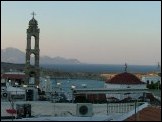
LINDOS is a village of about 1,500 people on the east coast of the island of Rodos, facing out into the Aegean towards Cyprus and the Middle East. It has had two heydays - one under the tyrant king Cleobolus in about 2,500 BC,when it was one of the Seven Kingdoms of the Dodecanese, and again under Turkish rule in the 18th century, when it was a major port and the town was substantially rebuilt. By the early 20th century it had largely fallen asleep again, and the Italian occupation barely disturbed it. When Lawrence Durrell came here in 1945 ('Reflections of a Marine Venus') it was virtually a ghost town.
The village has one of the most dramatic settings in the Dodecanese, dominated by the Acropolis and its 14th century fortress of the Knights of St John, and overlooking the stunning Lindos Bay and St Paul's Bay. The mountainous grey and black magma, shaped by volcanic eruptions and earthquakes, is offset by the bright white flat-roofed buildings of the modern town. Lindos was discovered by hippies in the 1970s, who turned it into a kind of Berkeley-by-Aegean - they were soon followed by the British holiday industry, and today Lindos is a slightly upmarket package tour
destination. The town has mostly weathered this well, not least because the streets are so narrow that no cars are allowed in, only motorbikes and donkeys.
Many of the older buildings have been turned into bars and restaurants, the newer buildings into studio apartments (there are no hotels in the town, thanks to the Greek Ministry of Culture declaring it a national heritage site) and so increasingly the local people have moved out into the surrounding villages. The busy tourist trade has attracted many workers, but they also tend to live in neighbouring villages, like Lardos and Pefki. This has had a significant effect on Lindos's churches.
Lindos has about a dozen churches, but only one of them, the 18th century Church of the Dormition of the Holy Mother of God, is of any size. The others tend to be tiny, fondant-ice shaped jewels, some dating from the 12th century but even the modern ones in the same style. These churches have almost entirely lost their parish populations, and most operate as little more than shrines. Unfortunately, most are kept locked. On the outskirts of town, on the road to Rodos town, a massive new church is being built, so that local people no longer need to make their way into to the centre of Lindos for the Liturgy. This, I am afraid, will eventually lead to the death of many of Lindos's churches.
click on images to go to that page
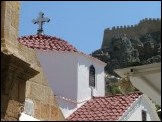
DORMITION OF THE HOLY MOTHER OF GOD - the main church of the town, and open daily from 7am to 7pm. You enter the courtyard from which the campanile rises - the bell here rings out the hours over town. You step into the back of the church, and then into the amazing, frescoed interior, the spectacular iconostasis ahead. As with all Greek Orthodox churches, photography is strictly forbidden - this normally wouldn't bother me, but I was never able to be in here on my own, so on this occasion I could not get away with it. You can then walk through the lemon trees across another courtyard to the Lindos Church Museum (entry 1.50 euro) which is splendid. Frescos from some of the other churches in the town have been lifted and reset in the walls, and there are icons and other treasures on display. Again, photography is forbidden, but this time I did manage to photograph what I wanted.
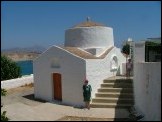
ST GEORGE CHOSTAS is the oldest church in town, dating from the 12th century. It is cruciform in a 'cross-in-square' style. As with many Lindos churches, the town has been built up around it, and to enter it is like going underground. Annoyingly, this is kept locked, and an American woman who came here as a hippy in the 1970s and now works in the Ikon gallery told me that it is very hard to get into. I wanted to see the famous Ikon of St George of Lindos, which is vast, painted on tin and set in the north transept. I passed the church on most days, rattling the door in frustration, but to no avail. But then, on the Feast of the Dormition, I was passing at about 10am and I saw an old woman go down the steps and let herself in! I hurried down after her, and my perakola? was answered with a smile. I stepped into the tiny church, ablaze with beeswax candles and the smell of chrism oil. The woman refilled the lamps, lit a few more candles.
The ikon is awesome, life-size and glimmering in the dark. I stood looking at it for a few moments, the woman watching me. When I had said a prayer and lit a candle, she led the way back outside into the blazing sunshine and locked the door behind her. I had been most fortunate.
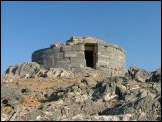
ST AEMILIANOS is probably the most fascinating. It is a rotunda, set on a rocky mound overlooking Lindos bay about three miles out from Lindos itself. The finger of magma curls back around, and the tower stands at the entry to the bay, a sheer drop 200ft below it. The only way to get there is to walk over the rocky terrain, which I did late one afternoon when the temperature had dropped (!) to about 40 degrees Celsius (104 degrees Fahrenheit). It is built out of blocks of black magma, and dates from about the first century BC. Obviously, it wasn't built as a church, but probably as some kind of funerary monument. It is called locally the Tomb of Cleobolus, but this isn't likely as it post-dates the tyrant king by about five centuries. It seems to have been converted into a church about the 4th century AD, and was possibly still in use as late as the 19th century, since there are remains of an abandoned settlement not far off, including a windmill and stone walls. Today, it is a very remote place indeed, and apart from a cross above the door and the brick outlining of an eastern apse, all there is inside is goat droppings.
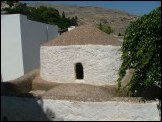
ST GEORGE PACHYMACHIOTES - a big name for a tiny cruciform church. As with St George Chostas, almost buried by later buildings. I never found it open.
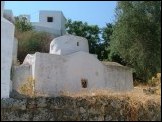
ST MENAS, however, is kept open all the time. It is very similar to St George Chostas, even down to an ikon of St George in the north transept. I was very pleased to be able to photograph its tiny interior, with a three bay iconostasis, and standing room for perhaps ten people. A beautiful olive tree outside is designed to shade those who can't get in.
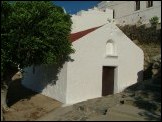
CHAPEL OF THE SAVIOUR is immediately beside and below St Menas. I never found it open.
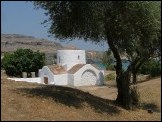
ST PETER, a cruciform church, has an idyllic setting down by the beach, set in a field like a jewel in a cushion. I never found it open.
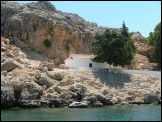
ST PAUL is interesting, because although it is fairly modern it sits beside St Paul's Bay, where the apostle is supposed to have come ashore when shipwrecked. Unusually, it is no longer in regular use by the Orthodox Church, and instead is used as a wedding venue. However, I noticed it was used for the Vigil Liturgy on the eve of the feast of the Dormition.
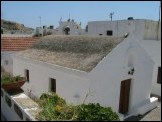
ST NICHOLAS is another relatively modern church, in a rectangular style like St Paul. It is severely hemmed in by restaurants and bars, and although its ornate gateway looks onto a tiny square, I never found the gates open, let alone the church.
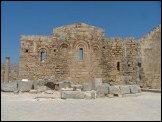
ST JOHN is the remains of a Knights of St John chapel within the Acropolis. All that survives is the outside wall.
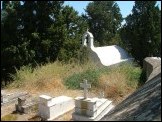
THE CEMETERY CHAPEL is just off the main square. Unfortunately, I never discovered its dedication, or even found it open.
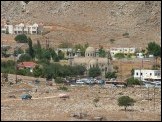
THE NEW CHURCH is being built up on the top road, and will completely dwarf the older churches of the town. So far, they have got as far as the concrete shell.
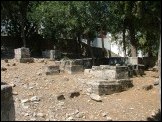
THE OLD TURKISH GRAVEYARD
survives - just. It has been severely desecrated, and
sits just below the square on the way to the beach.
Lindos, and all of Rodos, was under Turkish rule for
about four centuries until 1918 - at the end of the first
world war it was briefly free for a couple of years until
Mussolini took it over. It was reunited with Greece in
1945. As Lawrence Durrell observed, the cemetery
was the last resting place of civil servants, exiles, and
merchants who never made it home. Traces of painting
survive on some tombs, as well as just a couple of top
stones, which denote whether the occupant is male or
female. Otherwise, it is all very sad. Nobody seems to
care much about this place, or even know that it is there
- it isn't marked on any maps.